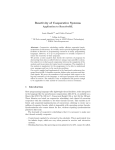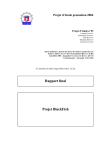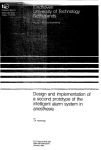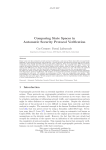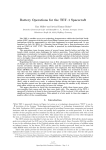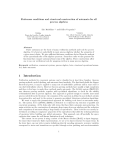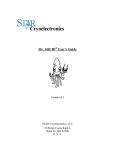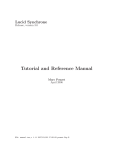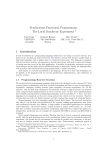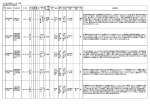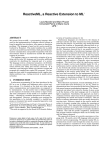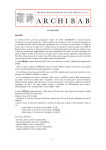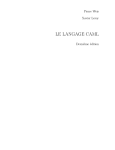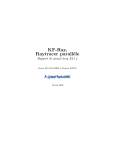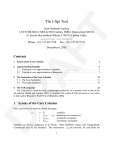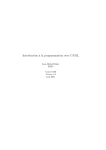Download Reactivity of Cooperative Systems: Application to ReactiveML
Transcript
Reactivity of Cooperative
Systems: Application to
ReactiveML
extended version
June 2014
Project-Teams PARKAS
ISSN 0249-6399
RESEARCH
REPORT
N° 8549
ISRN INRIA/RR--8549--FR+ENG
Louis Mandel, Cédric Pasteur
Reactivity of Cooperative Systems:
Application to ReactiveML
extended version
Louis Mandel, Cédric Pasteur
Project-Teams PARKAS
Research Report n° 8549 — June 2014 — 29 pages
Abstract: Cooperative scheduling enables efficient sequential implementations of concurrency.
It is widely used to provide lightweight threads facilities as libraries or programming constructs in
many programming languages. However, it is up to programmers to actually cooperate to ensure
the reactivity of their programs.
We present a static analysis that checks the reactivity of programs by abstracting them into socalled behaviors using a type-and-effect system. Our objective is to find a good compromise between
the complexity of the analysis and its precision for typical reactive programs. The simplicity of
the analysis is mandatory for the programmer to be able to understand error messages and how
to fix reactivity problems.
Our work is applied and implemented in the functional synchronous language ReactiveML. It
handles recursion, higher-order processes and first-class signals. We prove the soundness of our
analysis with respect to the big-step semantics of the language: a well-typed program with reactive
effects is reactive. The analysis is easy to implement and generic enough to be applicable to other
models of concurrency such as coroutines.
This research report is the extended version of the article [20] published at the 21st International
Static Analysis Symposium.
Key-words:
Cooperative scheduling; Type systems; Semantics; Functional languages; Synchronous languages
RESEARCH CENTRE
PARIS – ROCQUENCOURT
Domaine de Voluceau, - Rocquencourt
B.P. 105 - 78153 Le Chesnay Cedex
Réactivité des Systèmes Coopératifs :
Application à ReactiveML
version étendue
Résumé :
L’ordonnancement coopératif permet l’implémentation séquentielle efficace de la
concurrence. Il est largement utilisé pour fournir des threads légers sous forme de bibliothèques
ou de constructions de programmation dans de nombreux langages de programmation. Toutefois,
il appartient aux programmeurs d’appeler des primitives de coopération pour assurer la réactivité
de leurs programmes.
Nous présentons une analyse statique qui vérifie la réactivité des programmes en les abstrayant
en comportements à l’aide d’un système de types à effets. Notre objectif est de trouver un bon
compromis entre la complexité de l’analyse et sa précision pour les programmes réactifs typiques.
La simplicité de l’analyse est obligatoire pour que le programmeur soit en mesure de comprendre
les messages d’erreur et comment résoudre les problèmes de réactivité.
Notre travail est appliqué et mis en œuvre dans le langage synchrone fonctionnel ReactiveML.
Il gère la récursivité, les processus d’ordre supérieur et les signaux de première classe. Nous
prouvons la correction de notre analyse par rapport à la sémantique grands pas du langage : un
programme bien typé avec des effets réactifs est réactif. L’analyse est facile à mettre en œuvre et
assez générique pour être applicable à d’autres modèles de concurrence, tels que les coroutines.
Ce rapport de recherche est la version étendue de l’article [20] publié dans les actes de la
21ème édition de l’International Static Analysis Symposium.
Mots-clés : Ordonnancement coopératif; Systèmes de types; Sémantique; Langages fonctionnels; Langages synchrones
Reactivity of Cooperative Systems
1
3
Introduction
Most programming languages offer lightweight thread facilities, either integrated in the language
like the asynchronous computations [30] of F#, or available as a library like GNU Pth [12] for
C, Concurrent Haskell [15] or Lwt [34] for OCaml. These libraries are based on cooperative
scheduling: each thread of execution cooperates with the scheduler to let other threads execute.
This enables an efficient and sequential implementation of concurrency, allowing to create up to
millions of separate threads, which is impossible with operating system threads. Synchronization
also comes almost for free, without requiring synchronization primitives like locks.
The downside of cooperative scheduling is that it is necessary to make sure that threads
actually cooperate:
• Control must regularly be returned to the scheduler. This is particularly true for infinite
loops, which are very often present in reactive and interactive systems.
• Blocking functions, like operating system primitives for I/O, cannot be called.
The solution to the latter is simple: never use blocking functions inside cooperative threads.
All the facilities mentioned earlier provide either I/O libraries compatible with cooperative
scheduling or a means to safely call blocking functions. See Marlow et al. [22] for an overview
on how to implement such libraries.
Dealing with the first issue is usually the responsibility of the programmer. For instance, in
the Lwt manual [11], one can find:
[...] do not write function that may take time to complete without using Lwt [...]
The goal of this paper is to design a static analysis, called reactivity analysis, to statically remedy
this problem of absence of cooperation points. The analysis checks that the programmer does
not forget to cooperate with the scheduler. Our work is applied to the ReactiveML language [19],
which is an extension of ML with a synchronous model of concurrency [6] (Section 2). However,
we believe that our approach is generic enough to be applied to other models of concurrency (Section 6.5). The contributions of this paper are the following:
• A reactivity analysis based on a type-and-effect system [18] in Section 4. The computed
effects are called behaviors [3] and are introduced in Section 3. They represent the temporal
behaviors of processes by abstracting away values but keeping part of the structure of the
program and are used to check if processes cooperate or not. Exposing concurrency in the
language makes it possible to express the analysis easily, which would not have been the
case if concurrency had been implemented as a library.
• A novel approach to subeffecting [23], that is, subtyping on effects, based on row polymorphism [26] in Section 4.4. It allows to build a conservative extension of the existing type
system with little overhead.
• A proof of the soundness of the analysis (Section 4.5): a well-typed program with reactive
effects is reactive.
The paper ends with some examples (Section 5), discussion (Section 6) and related work (Section 7). The work presented here is implemented in the ReactiveML compiler1 and it has already
helped detecting many reactivity bugs. The implementation, the source code of the examples
and an online toplevel are available at http://reactiveml.org/sas14.
1 http://www.reactiveml.org
RR n° 8549
Reactivity of Cooperative Systems
2
4
Overview of the approach
ReactiveML extends ML with programming constructs inspired from synchronous languages [6].
It introduces a built-in notion of parallelism where time is defined as a succession of logical
instants. Each parallel process must cooperate to let time elapse. It is a deterministic model of
concurrency that is compatible with the dynamic creation of processes [9]. Synchrony gives us a
simple definition for reactivity: a reactive ReactiveML program is one where each logical instant
terminates.
Let us first introduce ReactiveML syntax and informal semantics using a simple program that
highlights the problem of non-reactivity. Then we will discuss the design choices and limitations
of our reactivity analysis using a few other examples.
2.1
A first example
We start by creating a process that emits a signal every timer seconds:2
1
2
3
4
5
6
let process clock timer s =
let time = ref (Unix.gettimeofday ()) in
loop
let time’ = Unix.gettimeofday () in
if time’ -. !time >= timer then (emit s (); time := time’)
end
In ReactiveML, there is a distinction between regular ML functions and processes, that is, functions whose execution can span several logical instants. Processes are defined using the process
keyword. The clock process is parametrized by a float timer and a signal s. Signals are communication channels between processes, with instantaneous broadcast. The process starts by
initializing a local reference time with the current time (line 2), read using the gettimeofday
function of the Unix module from the standard library. Then it enters an infinite loop (line 3
to 6). At each iteration, it reads the new current time and emits the unit value on the signal s
if enough time has elapsed (line 5). The compiler prints the following warning when compiling
this process:
W: Line 3, characters 2-115, this expression may be an instantaneous loop
The problem is that the body of the loop is instantaneous. It means that this process never
cooperates, so that logical instants do not progress. In ReactiveML, cooperating is done by
waiting for the next instant using the pause operator. We solve our problem by calling it at the
end of the loop (line 6):
5
6
7
if time’ -. !time >= timer then (emit s (); time := time’);
pause
end
The second part of the program is a process that prints top every time a signal s is emitted.
The do/when construct executes its body only when the signal s is present (i.e. it is emitted). It
terminates by returning the value of its body instantaneously after the termination of the body.
Processes have a consistent view of a signal’s status during an instant. It is either present or
absent and cannot change during the instant.
10
11
12
13
let process print_clock s =
loop
do
print_string "top"; print_newline ()
2 The
vocabulary is the one of synchronous languages, not the one of FRP.
RR n° 8549
Reactivity of Cooperative Systems
14
15
5
when s done
end
W: Line 11, characters 2-78, this expression may be an instantaneous loop
Once again, this loop can be instantaneous, but this time it depends on the presence of the
signal. While the signal s is absent, the process cooperates. When it is present, the body of
the do/when executes and terminates instantaneously. So the body of the loop also terminates
instantaneously, and a new iteration of the loop is started in the same logical instant. Since the
signal is still present, the body of the do/when executes one more time, and so on. This process
can also be fixed by adding a pause statement in the loop.
We can then declare a local signal s and put these two processes in parallel. The result is a
program that prints top every second:
17
18
19
let process main =
signal s default () gather (fun x y -> ()) in
run (print_clock s) || run (clock 1. s)
The declaration of a signal takes as arguments the default value of the signal and a combination
function that is used to compute the value of the signal when there are multiple emissions in
a single instant. Here, the default value is () and the signal keeps this value in case of multiemission. The || operator represents synchronous parallel composition. Both branches are
executed at each instant and communicate through the local signal s.
2.2
Intuitions and limitations
In the previous example, we have seen the first cause of non-reactivity: instantaneous loops. The
second one is instantaneous recursive processes:
let rec process instantaneous s =
emit s (); run (instantaneous s)
W: This expression may produce an instantaneous recursion
The execution of emit is instantaneous, therefore the recursive call creates a loop that never
cooperates. A sufficient condition to ensure that a recursive process is reactive is to have at
least one instant between the instantiation of the process and any recursive call. The idea of our
analysis is to statically check this condition.
This condition is very strong and is not always satisfied by interesting reactive programs. For
instance, it does not hold for a parallel map (the let/and construct executes its two branches in
parallel, matching is instantaneous):
let rec process par_map p l =
match l with
| [] -> []
| x :: l -> let x’ = run (p x)
and l’ = run (par_map p l) in x’ :: l’
W: This expression may produce an instantaneous recursion
This process has instantaneous recursive calls, but it is reactive because the recursion is finite
if the list l is finite. As the language allows to create mutable and recursive data structures, it
is hard to prove the termination of such processes. For instance, the following expression never
cooperates:
let rec l = 0 :: l in run (par_map p l)
Consequently, our analysis only prints warnings and does not reject programs.
ML functions are always considered instantaneous. So they are reactive if and only if they
terminate. Since we do not want to prove their termination, our analysis has to distinguish
RR n° 8549
Reactivity of Cooperative Systems
6
recursions through functions and processes. This allows us to assume that ML functions always
terminate and to issue warnings only for processes.
Furthermore, we do not deal with blocking functions, such as I/O primitives, that can also
make programs non-reactive. Indeed, such functions should never be used in the context of
cooperative scheduling. There are standard solutions for this problem [22].
This analysis does not either consider the presence status of signals. It over-approximates
the possible behaviors, as in the following example:
let rec process imprecise =
signal s default () gather (fun x y -> ()) in
present s then () else (* implicit pause *) ();
run imprecise
W: This expression may produce an instantaneous recursion
The present/then/else construct executes its first branch instantaneously if the signal is present
or executes the second branch with a delay of one instant if the signal is absent. This delayed
reaction to absence, first introduced by Boussinot [9], avoids inconsistencies in the status of
signals. In the example, the signal is absent so the else branch is executed. It means that the
recursion is not instantaneous and the process is reactive. Our analysis still prints a warning,
because if the signal s could be present, the recursion would be instantaneous.
Finally, we only guarantee that the duration of each instant is finite, not that the program
is real-time, that is, that there exists a bound on this duration for all instants, as shown in this
example:
let rec process server add =
await add(p, ack) in
run (server add) || let v = run p in emit ack v
The server process listens on a signal add to receive both a process p and a signal ack on which
to send back results. As it creates one new process each time the add signal is emitted, this
program can execute an arbitrary number of processes at the same time. It is thus not real-time,
but it is indeed reactive, as waiting for the value of a signal takes one instant (one has to collect
and combine all the values emitted during the instant).
3
The algebra of behaviors
The idea of our analysis is to abstract processes into a simpler language called behaviors, following
Amtoft et al. [3] and to check reactivity on these behaviors. The main design choice is to
completely abstract values and the presence of signals. It is however necessary to keep an
abstraction of the structure of the program in order to have a reasonable precision.
3.1
The behaviors
The algebra of behaviors is given by:3
κ ::= • | 0 | φ | κ || κ | κ + κ | κ; κ | µφ. κ | run κ
Actions that take at least one instant to execute, i.e. surely non-instantaneous actions, such
as pause, are denoted •. Potentially instantaneous ones, like calling a pure ML function or
emitting a signal, are denoted 0. The language also includes behavior variables φ to represent
the behaviors of processes taken as arguments, since ReactiveML has higher-order processes.
3 Precedence of operators is the following (from highest to lowest): run, ;, +, || and finally µ. For instance:
µφ. κ1 || run κ2 + •; κ3 means µφ. (κ1 || ((run κ2 ) + (•; κ3 ))).
RR n° 8549
Reactivity of Cooperative Systems
7
Behaviors must reflect the structure of the program, starting with parallel composition. This
is illustrated by the following example, which defines a combinator par_comb that takes as inputs
two processes q1 and q2 and runs them in parallel in a loop:
let process par_comb q1 q2 = loop (run q1 || run q2) end
The synchronous parallel composition terminates when both branches have terminated. It means
that the loop is non-instantaneous if either q1 or q2 is non-instantaneous. To represent such
processes, behaviors include the parallel composition, simply denoted ||. Similarly, we can define
another combinator that runs one of its two inputs depending on a condition c:
let process if_comb c q1 q2 = loop (if c then run q1 else run q2) end
In the case of if_comb, both processes must be non-instantaneous. As we want to abstract
values, we represent the different alternatives using a non-determinstic choice operator + and
forget about the conditions.
It is also necessary to have a notion of sequence, denoted ; in the language of behaviors, as
illustrated by the two following processes:
let rec process good_rec = pause; run good_rec
let rec process bad_rec = run bad_rec; pause
W: This expression may produce an instantaneous recursion
The order between the recursive call and the pause statement is crucial as the good_rec process
is reactive while bad_rec loops instantaneously. As it is defined recursively, the behavior κ associated with the good_rec process must verify that κ = •; run κ. The run operator is associated
with running a process. This equation can be solved by introducing an explicit recursion operator
µ so that κ = µφ. •; run φ. Recursive behaviors are defined as usual:
µφ. κ = κ[φ ← µφ. κ]
µφ. κ = κ if φ 6∈ fbv (κ)
We denote fbv (κ) the set of free behavior variables in κ. There is no operator for representing
the behavior of a loop. Indeed, a loop is just a special case of recursion. The behavior of a loop,
denoted κ∞ (where κ is the behavior of the body of the loop), is thus defined as a recursive
behavior by κ∞ , µφ. (κ; run φ).
3.2
Reactive behaviors
Using the language of behaviors, we can now characterize the behaviors that we want to reject,
that is instantaneous loops and recursions. To formally define which behaviors are reactive, we
first have to define the notion of a non-instantaneous behavior, i.e. processes that take at least
one instant to execute:
Definition 1 (Non-instantaneous behavior). A behavior is non-instantaneous, denoted κ ↓, if:
•↓
φ↓
κ1 ↓
κ2 ↓
κ1 ↓
κ2 ↓
κ1 ; κ2 ↓
κ1 ; κ2 ↓
κ1 || κ2 ↓
κ1 || κ2 ↓
κ1 ↓
κ2 ↓
κ1 + κ2 ↓
κ↓
µφ. κ ↓
κ↓
run κ ↓
Note that function calls are not non-instantaneous. The behavior • is as expected non-instantaneous. The fact that variables are considered non-instantaneous means that any process taken
as argument is supposed to be non-instantaneous. The reactivity is then checked when this
variable is instantiated with the actual behavior of the process. For the sequential and the
RR n° 8549
Reactivity of Cooperative Systems
8
parallel composition, only one of the two behaviors have to be non-instantaneous to makes the
whole behavior non-instantaneous. For a non-deterministic choice, the two behaviors have to be
non-instantaneous to be sure that the behavior is non-instantaneous since only one of the two
behaviors will be actually executed. Finally, the instantaneity of a recursive behavior or a run
only depends on the instantaneity of their body.
A behavior is said to be reactive if for each recursive behavior µφ. κ, the recursion variable φ
does not appear in the first instant of the body κ. This enforces that there must be at least one
instant between the instantiation of a process and each recursive call and is formalized in the
following definition.
Definition 2 (Reactive behavior). A behavior κ is reactive if ∅ ` κ, where the relation R ` κ
is defined by:
φ 6∈ R
R`0
R ` κ1
κ1 ↓
R ` κ1 ; κ2
R`•
∅ ` κ2
R ` κ1
R`φ
R ` κ1
R ` κ2
not(κ1 ↓)
R ` κ2
R ` κ1 ; κ2
R ` κ1
R ` κ1 || κ2
R ` κ2
R ` κ1 + κ2
R ∪ {φ} ` κ
R ` µφ. κ
R`κ
R ` run κ
The predicate R ` κ means that the behavior κ is reactive with respect to the set of variables
R, that is, these variables do not appear in the first instant of κ and all the recursions inside
κ are not instantaneous. The rule for a variable φ checks that φ is not a recursion variable
introduced in the current instant. The recursion variables are added to the set R when checking
the reactivity of a recursive behavior µφ. κ. In the case of the sequence κ1 ; κ2 , we can remove
variables from R if κ1 is non-instantaneous. One can also check from the definition of κ∞ as a
recursive behavior that this definition also implies that the body of a loop is non-instantaneous.
The behaviors 0 and • are always reactive. The other rules only checks that sub-expressions are
reactive.
Using this definition, we can see for example that the behavior µφ. •; φ is reactive:
φ`•
3.3
•↓
∅`φ
φ ` •; φ
∅ ` µφ. •; φ
Equivalence on behaviors
We can define an equivalence relation ≡ on behaviors that will be used to simplify the behaviors.
The relation is reflexive, symmetric and transitive closure of the following rules. The operators ;
and || and + are idempotent and associative. || and + are commutative (but not ; ). The 0 behavior (resp. •) is the neutral element of ; and || (resp. +). The relation also satisfies the following
rules (where op is ; or || or +):
κ1 ≡ κ2
µφ. κ1 ≡ µφ. κ2
κ1 ≡ κ2
run κ1 ≡ run κ2
•∞ ≡ •
κ1 ≡ κ01
κ2 ≡ κ02
κ1 op κ2 ≡ κ01 op κ02
It is easy to show, for example, that: µφ. ((• || 0); (run φ + run φ)) ≡ µφ. (•; run φ).
An important property of this relation is that it preserves reactivity. It is expressed as follows:
Property 1. if κ1 ≡ κ2 and R ` κ1 then R ` κ2 .
Proof. By induction on the proof of κ1 ≡ κ2 .
RR n° 8549
Reactivity of Cooperative Systems
4
9
The type-and-effect system
The link between processes and behaviors is done by a type-and-effect system [18], following the
work of Amtoft et al. [3]. The behavior of a process is its effect computed using the type system.
After type-checking, the compiler checks the inferred behaviors and prints a warning if one of
them is not reactive.
The type system is a conservative extension of the original one of ReactiveML, that is, it is
able to assign a behavior to any ReactiveML program that was accepted previously. It is an
important feature as we only want to show warnings and not reject programs.
A type system is a simple way to specify a higher-order static analysis. It can be implemented
efficiently using classic destructive unification techniques [16].
4.1
Abstract syntax
We consider here a kernel of ReactiveML:
v ::= c | (v, v) | n | λx.e | process e
e ::= x | c | (e, e) | λx.e | e e | rec x = v | process e | run e | pause
| let x = e and x = e in e | signal x default e gather e in e | emit e e
| present e then e else e | loop e | do e until e(x) → e | do e when e
Values are constants c (integers, unit value (), etc.), pairs of values, signal names n, functions
and processes. The language is a call-by-value lambda-calculus, extended with constructs for
creating (process) and running (run) processes, waiting for the next instant (pause), parallel
definitions (let/and), declaring signals (signal), emitting a signal (emit) and several control
structures: the test of presence of a signal (present), the unconditional loop (loop), weak preemption (do/until) and suspension (do/when). The expression do e1 until s(x) → e2 executes
its body e1 and interrupts it if s is present. In case of preemption, the continuation e2 is executed
on the next instant, binding x to the value of s. We denote variables that do not appear free in
the body of a let and () the unique value of type unit. From this kernel, we can encode most
constructs of the language:
e1 || e2 , let = e1 and = e2 in ()
e1 ; e2 , let = () and = e1 in e2
await e1 (x) in e2 , do (loop pause) until e1 (x) → e2
let rec process f x1 . . . xp = e1 in e2
, let f = (rec f = λx1 . . . . λxp .process e1 ) in e2
4.2
Types
Types are defined by:
τ ::= α | T | τ × τ | τ → τ | τ process[κ] | (τ, τ ) event
(types)
σ ::= τ | ∀φ. σ | ∀α. σ
(type schemes)
Γ ::= ∅ | Γ, x : σ
(environments)
A type is either a type variable α, a base type T (like bool or unit), a product, a function, a
process or a signal. The type of a process is parametrized by its return type and its behavior.
The type (τ1 , τ2 ) event of a signal is parametrized by the type τ1 of emitted values and the
type τ2 of the received value (since a gathering function of type τ1 → τ2 → τ2 is applied).
RR n° 8549
Reactivity of Cooperative Systems
10
Types schemes quantify universally over type variables α and behavior variables φ. We denote
ftv (τ ) (resp. fbv (τ )) the set of type (resp. behavior) variables free in τ and fv (τ ) = ftv (τ ), fbv (τ ).
Instantiation and generalization are defined in a classic way:
σ[α ← τ ] ≤ ∀α. σ
σ[φ ← κ] ≤ ∀φ. σ
gen(τ, e, Γ) = τ
if e is expansive
gen(τ, e, Γ) = ∀ᾱ.∀φ̄. τ where ᾱ, φ̄ = fv (τ ) \ fv (Γ)
otherwise
Analogously to the treatment of references in ML, we must be careful not to generalize expressions that allocate signals. We use the syntactic criterion of expansive and non-expansive
expressions [33]. An expression is expansive if it can allocate a signal or a reference, in which case
its type should not be generalized. Here is an example of program wrong program that would
have been accepted if there is no distinction between expansive and non-expansive expressions.
let emit_s =
signal s default [] gather (fun x y -> x :: y) in
(fun x -> emit x)
in
emit_s 1
emit_s "error"
The notions of reactivity and equivalence are lifted from behaviors to types. A type is reactive
if it contains only reactive behaviors. Two types are equivalent, also denoted τ1 ≡ τ2 , if they
have the same structure and their behaviors are equivalent.
4.3
Typing rules
Typing judgments are given by Γ ` e : τ | κ meaning that, in the type environment Γ, the
expression e has type τ and behavior κ. We write Γ ` e : τ | ≡ 0 when the behavior of the
expression e is equivalent to 0. The initial typing environment Γ0 gives the types of primitives:
Γ0 , [true : bool; fst : ∀α1 , α2 . α1 × α2 → α1 ; . . .]
The rules defining the type system are given in Figure 1. If all the behaviors are erased, it
is exactly the same type system as the one presented in [19], which is itself an extension of the
ML type system. We discuss here the novelties of the rules related to behaviors:
• The Process rule stores the behavior of the body in the type of the process, as usual in
type-and-effect systems. The presence of the κ0 behavior and the Mask rule are related to
subeffecting and will be discussed in Section 4.4.
• A design choice made in ReactiveML is to separate pure ML expressions, that are surely
instantaneous, from processes. For instance, it is impossible to call pause within the body of
a function, that must be instantaneous. A static analysis (used for efficient code generation)
performed before typing checks this well-formation of expressions, denoted k ` e in [19] and
recalled in Appendix A. Requiring the behavior of some expressions, like the arguments
of an application or the body of a function, to be equivalent to 0 does not add any new
constraint with respect to this existing analysis.
• We do not try to prove the termination of pure ML functions without any reactive behavior.
The App rule shows that we assume that function calls always terminate instantaneously.
That is why there is no behavior associated with functions: there are no behaviors on arrow
types unlike traditional type-and-effect systems.
RR n° 8549
Reactivity of Cooperative Systems
τ ≤ Γ(x)
Γ`x:τ |0
11
Γ ` e2 : τ2 | ≡ 0
Γ ` e1 : τ1 | ≡ 0
Γ ` (e1 , e2 ) : τ1 × τ2 | 0
τ ≤ Γ0 (c)
Γ`c:τ |0
Γ, x : τ1 ` e : τ2 | ≡ 0
Γ ` λx.e : τ1 → τ2 | 0
Γ, x : τ ` v : τ | ≡ 0
Γ ` rec x = v : τ | 0
(App)
Γ ` e1 : τ2 → τ1 | ≡ 0
Γ ` e2 : τ2 | ≡ 0
Γ ` e1 e2 : τ1 | 0
(Process)
Γ`e:τ |κ
Γ ` process e : τ process[κ + κ0 ] | 0
Γ ` e : τ process[κ] | ≡ 0
Γ ` run e : τ | run κ
Γ ` e1 : τ1 | κ1
Γ ` pause : unit | •
Γ ` e2 : τ2 | κ2 Γ, x1 : gen(τ1 , e1 , Γ), x2 : gen(τ2 , e2 , Γ) ` e3 : τ | κ3
Γ ` let x1 = e1 and x2 = e2 in e3 : τ | (κ1 || κ2 ); κ3
Γ ` e1 : τ2 | ≡ 0
Γ ` e2 : τ1 → τ2 → τ2 | ≡ 0
Γ, x : (τ1 , τ2 ) event ` e : τ | κ
Γ ` signal x default e1 gather e2 in e : τ | 0; κ
Γ ` e : (τ1 , τ2 ) event | ≡ 0
Γ ` e1 : τ | κ1
Γ ` e2 : τ | κ2
Γ ` present e then e1 else e2 : τ | κ1 + (•; κ2 )
Γ ` e2 : τ1 | ≡ 0
Γ ` e1 : (τ1 , τ2 ) event | ≡ 0
Γ ` emit e1 e2 : unit | 0
Γ ` e1 : τ | κ1
Γ`e:τ |κ
Γ ` loop e : unit | (0; κ)∞
Γ ` e : (τ1 , τ2 ) event | ≡ 0
Γ, x : τ2 ` e2 : τ | κ2
Γ ` do e1 until e(x) → e2 : τ | κ1 + (•; κ2 )
Γ ` e1 : τ | κ
Γ ` e : (τ1 , τ2 ) event | ≡ 0
Γ ` do e1 when e : τ | κ + •∞
(Mask)
Γ`e:τ |κ
φ 6∈ f bv(Γ, τ )
Γ ` e : τ | κ[φ ← •]
Figure 1: Type-and-effect rules
• In the case of present e then e1 else e2 , the first branch e1 is executed immediately
if the signal e is present and the second branch e2 is executed at the next instant if it
is absent. This is reflected in the behavior associated with the expression. Similarly, for
do e1 until e(x) → e2 , the expression e2 is executed at the instant following the presence
of e.
• The encoding of primitives given earlier yields the expected behaviors. For example, consider the case of e1 ; e2 :
Γ ` e1 : τ1 | κ1
Γ ` () : unit | 0 Γ ` e2 : τ2 | κ2
Γ ` let = e1 and = () in e2 : τ2 | (κ1 || 0); κ2
Γ ` e1 ; e2 : τ2 | (κ1 || 0); κ2
It is easy to show that (κ1 || 0); κ2 ≡ κ1 ; κ2 . We can also show that e1 || e2 has a behavior
RR n° 8549
Reactivity of Cooperative Systems
12
equivalent to κ1 || κ2 or that await e1 (x) in e2 has behavior •∞ + (•; κ2 ) ≡ •; κ2 (reading
the value of a signal takes at least one instant).
• The pause operator cannot be encoded using the delay to the reaction to absence as in [19]
by:
pause , signal s default () gather (λx.λy.()) in
present s then () else ()
We have chosen to completely abstract values. As in the imprecise example of Section 2.2,
we do not consider the fact that the signal s is always absent, so that only the second
branch of the present is executed. The consequence is that the behavior computed for
this encoding, that is, 0; (0 + (•; 0)) ≡ 0, is the opposite of the expected behavior of pause.
• The loop construct can be encoded as a recursive process by:
loop e ,
run ((rec l = λx.process (run x; run (l x))) (process e))
Unlike pause, we could have removed loop from our kernel and used this encoding without
affecting the results given by the reactivity analysis. Indeed, by applying the rules here,
we have that:
loop : ∀φ. α process[φ] → α0 process[µφ0 . run φ; run φ0 ]
If we assume that Γ ` e : τ | κ, then the behavior of this encoding is: run (µφ0 . run κ; run φ0 ).
It is not equivalent to κ∞ in the sense of Section 3.3, but it is reactive iff κ∞ is reactive,
as the run operator does not influence reactivity (see Definition 2).
• The reason why the behavior associated with loop is equal to (0; κ)∞ and not simply κ∞
will be explained in Section 4.5. Intuitively, the soundness proof will use an induction on
the size of the behaviours and thus requires the behavior of a sub-expression to always be
smaller. This also applies for signal and do/when.
• Finally, note that there is no special treatment for recursive processes. We will see in the
next section that recursive behaviors are introduced during unification. An example of
typing derivation justifying the presence of the run operator will be given in Section 6.1.
4.4
Subeffecting with row polymorphism
The typing rule (Process) for the creation of processes intuitively mean that a process has at
least the behavior of its body. The idea is to add a free behavior variable to represent other
potential behaviors of the process. This subtyping restricted to effects is often referred to as
subeffecting [23]: we can always replace an effect with a bigger, i.e. less precise, one. It allows to
assign a behavior to any correct ReactiveML program. For instance, it is possible to build a list
of two processes with different behaviors (the • behavior is printed ’*’ and behavior variables φ
are denoted ’r):
let
val
let
val
let
val
process p1 = ()
p1: unit process[0 + ’r1]
process p2 = pause
p2: unit process[* + ’r2]
l = [p1; p2]
l: unit process[0 + * + ’r] list
RR n° 8549
Reactivity of Cooperative Systems
13
If the behavior of a process had been exactly equal to the behavior of its body, this expression
would have been rejected by the type system.
The consequence of the typing rule for processes is that the principal type of an expression
process e is always of the form κ + φ where κ is the behavior of e and φ a free variable.
The idea to use a free type variable to represent other possible types is reminiscent of Remy’s
row types [26]. It makes it possible to implement subeffecting using only unification, without
manipulating constraint sets as in traditional approaches [31, 3]. It thus becomes easier to
integrate it into any existing ML type inference implementation. For instance, OCaml type
inference is also based on row polymorphism [27], so it would be easy to implement our type
system on top of the full language.
We can reuse any existing inference algorithm, like algorithm W or M [16] and add only the
following algorithm Uκ for unification of behaviors. It takes as input two behaviors and returns a
substitution that maps behavior variables to behaviors, that we denote [φ1 7→ κ1 ; φ2 7→ κ2 ; . . . ].
During unification, the behavior of a process is always either a behavior variable φ, a row κ + φ
or a recursive row µφ. (κ + φ0 ). Therefore, the unification algorithm only has to consider these
cases:
Uκ (κ, κ) = []
(
Uκ (φ, κ) = Uκ (κ, φ) =
[φ 7→ µφ. κ]
[φ 7→ κ]
if occur check(φ, κ)
otherwise
Uκ (κ1 + φ1 , κ2 + φ2 ) = [φ1 7→ κ2 + φ; φ1 7→ κ1 + φ], φ fresh
Uκ (µφ01 . (κ1 + φ1 ), κ2 ) = Uκ (κ2 , µφ01 . (κ1 + φ1 ))
= let K1 = µφ01 . (κ1 + φ1 ) in Uκ (κ1 [φ01 ← K1 ] + φ1 , κ2 )
It should be noted that unification never fails, so that we obtain a conservative extension of
ReactiveML type system. This unification algorithm reuses traditional techniques for handling
recursive types [13]. The last case unfolds a recursive row to reveal the row variable, so that it
can be unified with other rows.
A downside of our approach is that it introduces one behavior variable for each process, so
that the computed behaviors may become very big and unreadable. The purpose of the Mask
rule is to remedy this, by using effect masking [18]. The idea is that if a behavior variable
appearing in the behavior is free in the environment, it is not constrained so we can give it any
value. In particular, we choose to replace it with •, which is the neutral element of +, so that it
can be simplified away.
Comparison with traditional approaches
Usually, subeffecting is not expressed as a syntax directed rule. For instance, in [31, 23], it is
defined as (we reuse the notations of our type system for comparison):
Γ`e:τ |κ
κ v κ0
Γ ` e : τ | κ0
The order v on effects is given by set inclusion when effects are sets [31] (of regions for example).
In our case, it is defined by:
κ1 v κ1 + κ2
κ2 v κ1 + κ2
κ1 ≡ κ2
κ1 v κ2
In the work of Amtoft et al. [3], effects must be simple, that is, effects on arrows are syntactically
forced to be variables. A constraint set C is added to the type system to keep track of the
RR n° 8549
Reactivity of Cooperative Systems
14
relations between variables and effects. Subeffecting is then expressed as:
Γ, C ` e : τ | κ
Γ, C ∪ {κ v φ} ` process e : τ process[φ] | 0
These three formulations appear to be equivalent. Indeed, our system and the one of Amtoft et
al. [3] are just syntax-directed versions of the classic approach, where the subsumption rule is
mixed with lambda abstractions (or process abstractions in our case).
4.5
Proof of soundness
We now present the proof sketch of the soundness of our analysis, that is, that at each instant,
the program admits a finite derivation in the big-step semantics of the language and rewrites to
a well-typed program with reactive effects.
The big-step semantics of ReactiveML, also called the behavioral semantics in reference to
the semantics of Esterel [25], describes the reaction of an expression during an instant i by the
smallest signal environment Si (the set of present signals) such that:
Ei ,bi
ei −−−→ ei+1
Si
which means that during the instant i, in the signal environment Si , the expression ei rewrites
to ei+1 and emits the signals in Ei . The boolean bi indicates if ei+1 has terminated. Additional
conditions express, for instance, the fact that the emitted values in Ei must agree with the signal
environment Si . An execution of a program comprises a succession of a (potentially infinite)
number of reactions and terminates when the status bi is equal to true. The definition of the
semantics was introduced in [19] and is recalled in Appendix B.
A program is reactive if at each instant, the semantics derivation of ei is finite. To prove that,
we first isolate the first instant of the behavior of ei , noted fst(κi ). This function is formally
defined by:
fst(0) = fst(•) = 0
fst(φ) = φ
fst(run κ) = run (fst(κ))
fst(κ1 || κ2 ) = fst(κ1 ) || fst(κ2 )
fst(κ1 + κ2 ) = fst(κ1 ) + fst(κ2 )
(
fst(κ1 )
fst(κ1 ; κ2 ) =
fst(κ1 ); fst(κ2 )
if κ1 ↓
otherwise
fst(µφ. κ) = fst(κ[φ ← µφ. κ])
The important property of this function is that if a behavior κi of ei is reactive (as defined in
Section 3.2), then fst(κi ) is finite. Hence we can prove by induction on the size of fst(κi ) that
the semantics derivation is finite. The soundness theorem is stated as follows:
Theorem 2 (Soundness). If Γ ` e : τ | κ and τ and κ are reactive and we suppose that function
E,b
calls terminate, then there exists e0 such that e −−→ e0 and Γ ` e0 : τ | κ0 with κ0 reactive.
S
Proof. The proof has two parts. The first part is the proof that the result is well-typed. We use
classic syntactic techniques for type soundness [24] on the small-step semantics described in [19].
RR n° 8549
Reactivity of Cooperative Systems
15
The proof of equivalence of the two semantics is also given in the same paper. The second part
is the proof that the semantics derivation of one instant is finite by induction on the size of the
first-instant behavior of well-typed expressions. We only consider one instant because thanks to
type preservation, if the theorem is true for one instant, it is true for the following ones. The
details of the proof are given in Appendix C.
5
Examples
We present here the result of the analysis on some examples. These examples can be downloaded
and tried at http://reactiveml.org/sas14.
Using a type-based analysis makes it easy to deal with cases of aliasing, as in the following
example:4
let rec process p =
let q = (fun x -> x) p in
run q
val p: ’a process[rec ’r. (run ’r + ..)]
W: This expression may produce an instantaneous recursion
The process q has the same type as p, and thus the same behavior, so the instantaneous recursion
is easily detected. As for objects in OCaml [27], row variables that appear only once are printed
‘..’.
The analysis can also handle combinators. For instance, the type system computes the
following behavior for the par_comb example of Section 3.1:
let process par_comb q1 q2 =
loop
run q1 || run q2
end
val par_comb: ’a process[’r1] -> ’b process [’r2] ->
unit process[rec ’r3. ((run ’r1 || run ’r2); ’r3 + ..)]
There is no warning when defining the combinator because it is not possible to decide its reactivity. Indeed, the synchronous parallel composition terminates when both branches have
terminated. It means that the loop is non-instantaneous if either q1 or q2 is non-instantaneous.
Formally, the computed behavior is reactive because free behavior variables are considered to
be non-instantaneous (see Definition 2). The reactivity is then checked at the instantiation. If
we instantiate the par_comb combinator with two anonymous processes, one instantaneous and
the other non-instantaneous, then we obtain a process that is indeed reactive, so no warning is
printed:
let process p1 =
run (par_comb (process ()) (process (pause)))
val p1: unit process[run(rec ’r.(run 0 || run *);’r) + ..]
However, if the two processes are instantaneous, then the loop becomes instantaneous. The
behavior that results is obviously non-reactive, so a warning is shown:
let process p2 =
run (par_comb (process ()) (process ()))
val p2: unit process[run(rec ’r.(run 0||run 0);’r) + ..)]
W: This expression may produce an instantaneous recursion
Here is another more complex example using higher-order functions and processes. We define
a function h_o that takes as input a combinator f. It then creates a recursive process that
4 Some
behaviors are simplified using the extension described in Appendix D.
RR n° 8549
Reactivity of Cooperative Systems
16
applies f to itself and runs the result:
let h_o f =
let rec process p =
let q = f p in run q
in p
val h_o: (’a process[run ’r1 + ’r2] -> ’a process[’r1])
-> ’a process[run ’r1 + ’r2]
If we instantiate this function with a process that waits an instant before calling its argument,
we obtain a reactive process:
let process good =
run (h_o (fun x -> process (pause; run x)))
val good: ’a process[run (run (rec ’r1. *; run (run ’r1))) + ..]
This is no longer the case if the process calls its argument instantaneously. The instantaneous
recursion is again detected by our static analysis:
let process pb =
run (h_o (fun x -> process (run x)))
val pb: ’a process[run (run (rec ’r1. run run ’r1)) + ..]
W: This expression may produce an instantaneous recursion
Another process that can be analyzed is a fix-point operator. It takes as input a function
expecting a continuation, and applies it with itself as the continuation. This fix-point operator
can be used to create a recursive process:
let rec fix f x = f (fix f) x
val fix: ((’a -> ’b) -> ’a -> ’b) -> ’a -> ’b
let process main =
let process p k v =
print_int v; run (k (v+1))
in run (fix p 0)
val main: ’a process[(run (rec ’r. run ’r)) + ..]
W: This expression may produce an instantaneous recursion
In the example, the analysis detects the problem of reactivity although there is no explicit
recursive process.
6
6.1
Discussion
The run operator
So far, we have not justified the presence of the run operator in the language of behaviors. It is
there to ensure that, even after adding simplification to the type system, the behavior associated
with a recursive process is always a recursive behavior, that is, µφ. κ with φ ∈ fbv (κ).
Suppose that we remove the run operator from the language of behaviors. Now, consider
the process rec p = process (run p). In the type system without run, we could give it the
instantaneous behavior 0 and miss the instantaneous recursion:
Γ0 `S p : β process[0 + •] | 0
Γ0 `S run p : β | 0 + •
0+•≡0
Equiv
0
Γ `S run p : β | 0
Γ0 `S process (run p) : β process[0 + •] | 0
Γ `S rec p = process (run p) : β process[0] | 0
RR n° 8549
Reactivity of Cooperative Systems
17
where Γ0 = Γ, p : β process[0 + •]. Thanks to the addition of run, run p now has a behavior
equal to run φ. Then, the only way to type the process is to give it the behavior µφ. (run φ + κ0 )
(where κ0 is not constrained). This also explains why there is no equivalence rule to simplify a
run. For instance, run 0 is not equivalent to 0.
6.2
Implementation
The type inference algorithm of ReactiveML has been extended to compute the behaviors of
processes, with minimal impact on its structure and complexity thanks to the use of row polymorphism for subeffecting (see Section 4.4). The rules given in Section 3.2 are easily translated
into an algorithm for checking the reactivity of behaviors that is polynomial in the size of behaviors. Inference simplifies behaviors during the computation, but does not necessarily compute
the smallest behavior possible. For instance, simplifying κ + κ can be costly in some cases, so it
only checks simple cases (e.g. if κ = 0 or κ = •).
In practice, the analysis has an impact on the type-checking time but it is negligible compared
to the global compilation time. For example on a 1.7GHz Intel Core i5 with 4Go RAM, the
compilation of the examples of the ReactiveML distribution (about 5000 lines of code) takes
about 0.15s where 0.02s are spent in the type checker (0.005s without the reactivity analysis).
Then it takes 3.5s to compile the generated OCaml code.
6.3
Handling references
References are not included in the kernel of our language. However, they are relevant as they
can be used to encode recursivity, as in the following example that creates a process that loops
instantaneously:
let landin () =
let f = ref (process ()) in
f := process (run !f);
!f
val landin: unit ->
unit process[0 + (rec ’r1. run (0 + ’r1)) + ..]
W: This expression may produce an instantaneous recursion
As our analysis does not have any special case for recursive processes and only relies on unification, it is able to detect such reactivity problems even though there is no explicit recursion.
6.4
Evaluation
The analysis is very useful to detect early small reactivity bugs such as the one presented Section 2.1. We have also used the analysis on bigger applications: a mobile ad-hoc network simulator (1800 Source Lines Of Code), a sensor network simulator (1700 SLOC), and a mixed music
sequencer (3400 SLOC).
There is no warning for both simulators. For the mixed music sequencer, there are warnings
on eleven processes. Eight warnings are due to structural recursions (similar to the example
par_map). Most of them come from the fact that the program is a language interpreter defined as
a set of mutually recursive processes on the abstract syntax tree. Another warning comes from
a record containing a process that is not annotated with a non-instantaneous behavior. The last
two warnings are due to loops around the execution of a musical score. In this case, the analysis
does not use the fact that the score is a non-empty list.
RR n° 8549
Reactivity of Cooperative Systems
18
In all these cases, it was easy for the programmer to check that these warnings were false
positives. The last three warnings can be removed by adding a pause in parallel to the potentially
instantaneous expressions.
6.5
Other models of concurrency
We have already extended our analysis to take into account time refinement [21]. We believe
this work could be applied to other models of concurrency. One just needs to give the behavior •
to operations that cooperate with the scheduler, like yield. We are considering an extension to
the X10 language,5 where cooperation points could be clocks.
In a synchronous world, the fact that each process cooperates at each instant implies the
reactivity of the whole program, as processes are executed in lock-step. In another model,
assumptions on the fairness of the scheduler may be required. This should not be a major
obstacle, as these hypotheses are already made in most systems, e.g. in Concurrent Haskell [15].
The distinction between processes and functions is important to avoid showing a warning for all
recursive functions.
7
Related work
The analysis of instantaneous loops is an old topic on which much has already been written, even
recently [1, 14, 4]. It is related to the analysis of productivity and deadlocks in list programs [29]
or guard conditions in proof assistants [5], etc. Our purpose was to define an analysis that can
be used in the context of a general purpose language (mutable values, recursion, etc.). We tried
to find a good compromise between the complexity of the analysis and its precision for typical
reactive programs written in ReactiveML. The programmer must not be surprised by the analysis
and the error messages. We focus here only on directly related work.
Our language of behaviors and type system are inspired by the work of Amtoft et al. [3].
Their analysis is defined on the ConcurrentML [28] language, which extends ML with message
passing primitives. The behavior of a process records emissions and receptions on communication
channels. The authors use the type system to prove properties on particular examples, not for a
general analysis. For instance, they prove that emission on a given channel always precedes the
emission on a second channel in a given program. The idea of using a type-and-effect system
for checking reactivity or termination is not new. For instance, Boudol [8] uses a type-and-effect
system to prove termination of functional programs using references, by stratifying memory to
avoid recursion through references.
Reactivity analysis is a classic topic in synchronous languages, that can also be related to
causality. In Esterel [25], the first imperative synchronous language, it is possible to react
immediately to the presence and the absence of a signal. The consequence is that a program can
be non-reactive because there is no consistent status for a given signal: the program supposes
that a signal is both present and absent during the same instant. This problem is solved by
checking that programs are constructively correct [25]. Our concurrency model, inherited from
the work of Boussinot [9], avoids these problems by making sure that processes are causal by
construction. We then only have to check that loops are not instantaneous, which is called loopsafe by Berry [25]. It is easy to check that an Esterel program is loop-safe as the language is
first order without recursion [32].
Closer to ReactiveML, the reactivity analysis of FunLoft [2] not only checks that instants
terminate, but also gives a bound on the duration of the instants through a value analysis.
5 http://x10-lang.org/
RR n° 8549
Reactivity of Cooperative Systems
19
The analysis is also restricted to the first-order setting. In ULM [7], each recursive call induces
an implicit pause. Hence, it is impossible to have instantaneous recursions, at the expense of
expressivity. For instance, in the server example of Section 2.2, a message could be lost between
receiving a message on add and awaiting a new message.
The causality analysis of Lucid Synchrone [10] is a type-and-effect system using row types. It
is based on the exception analysis defined by Leroy et al. [17]. Both are a more direct application
of row types [26], whereas our system differs in the absence of labels in rows.
8
Conclusion
We have presented a reactivity analysis for the ReactiveML language. The idea of the analysis
is to abstract processes into a simpler language called behaviors using a type-and-effect system.
Checking reactivity of behaviors is then straightforward. We have proven the soundness of our
analysis, that is, that a well-typed program with reactive effects is reactive. Thanks in particular
to the syntactic separation between functions and processes, the analysis does not detect too
many false positives in practice. It is implemented in the ReactiveML compiler and it has been
proven very useful for avoiding reactivity bugs. We believe that this work can be applied to other
models of cooperative scheduling.
Acknowledgments
This work would not have been possible without previous experiments made with Florence
Plateau and Marc Pouzet. Timothy Bourke helped us a lot in the preparation of this article. We are grateful for the proofreading and discussions with Guillaume Baudart and Adrien
Guatto. Finally, we also thank the reviewers for there numerous comments and suggestions.
References
[1] Abel, A., Pientka, B.: Well-founded recursion with copatterns. In: International Conference
on Functional Programming. (2013)
[2] Amadio, R., Dabrowski, F.: Feasible reactivity in a synchronous π-calculus. In: Principles
and Practice of Declarative Programming. (2007) 221–230
[3] Amtoft, T., Nielson, F., Nielson, H.: Type and Effect Systems: Behaviours for Concurrency.
Imperial College Press (1999)
[4] Atkey, R., McBride, C.: Productive coprogramming with guarded recursion. In: International Conference on Functional Programming. (2013)
[5] Barthe, G., Frade, M.J., Giménez, E., Pinto, L., Uustalu, T.: Type-based termination of
recursive definitions. Mathematical Structures in Computer Science 14(01) (2004) 97–141
[6] Benveniste, A., Caspi, P., Edwards, S.A., Halbwachs, N., Guernic, P.L., De Simone, R.:
The synchronous languages twelve years later. In: Proc. of the IEEE. (2003)
[7] Boudol, G.: ULM: A core programming model for global computing. In: European Symposium on Programming. (2004)
[8] Boudol, G.: Typing termination in a higher-order concurrent imperative language. Information and Computation 208(6) (2010) 716–736
RR n° 8549
Reactivity of Cooperative Systems
20
[9] Boussinot, F.: Reactive C: an extension of C to program reactive systems. Software:
Practice and Experience 21(4) (1991) 401–428
[10] Cuoq, P., Pouzet, M.: Modular Causality in a Synchronous Stream Language. In: European
Symposium on Programming. (2001)
[11] Dimino, J.: Lwt User Manual. (2014) http://ocsigen.org/lwt/.
[12] Engelschall, R.: Portable multithreading: The signal stack trick for user-space thread
creation. In: USENIX Annual Technical Conference. (2000)
[13] Huet, G.: A unification algorithm for typed λ-calculus. Theoretical Computer Science 1(1)
(1975) 27–57
[14] Jeffrey, A.: Functional reactive programming with liveness guarantees. In: International
Conference on Functional Programming. (2013)
[15] Jones, S., Gordon, A., Finne, S.:
Languages. (1996) 295–308
Concurrent Haskell. In: Principles of Programming
[16] Lee, O., Yi, K.: Proofs about a folklore let-polymorphic type inference algorithm. Transactions on Programming Languages and Systems 20(4) (1998) 707–723
[17] Leroy, X., Pessaux, F.: Type-based analysis of uncaught exceptions. Transactions on
Programming Languages and Systems 22(2) (2000) 340–377
[18] Lucassen, J.M., Gifford, D.K.: Polymorphic effect systems. In: Principles of Programming
Languages. (1988)
[19] Mandel, L., Pouzet, M.: ReactiveML: a reactive extension to ML. In: Principles and
Practice of Declarative Programming. (2005)
[20] Mandel, L., Pasteur, C.: Reactivity of cooperative systems: Application to ReactiveML.
In: Static Analysis Symposium. (2014)
[21] Mandel, L., Pasteur, C., Pouzet, M.: Time refinement in a functional synchronous language.
In: Principles and Practice of Declarative Programming. (2013)
[22] Marlow, S., Jones, S., Thaller, W.: Extending the Haskell foreign function interface with
concurrency. In: Haskell’04, ACM (2004) 22–32
[23] Nielson, F., Nielson, H.: Type and effect systems. Correct System Design (1999)
[24] Pierce, B.: Types and programming languages. The MIT Press (2002)
[25] Potop-Butucaru, D., Edwards, S.A., Berry, G.: Compiling Esterel. Springer (2007)
[26] Rémy, D.: Type inference for records in a natural extension of ML. Theoretical Aspects of
Object-Oriented Programming. MIT Press (1993)
[27] Rémy, D.: Using, understanding, and unraveling the OCaml language from practice to
theory and vice versa. In: Applied Semantics. Springer (2002) 413–536
[28] Reppy, J.: Concurrent programming in ML. Cambridge University Press (2007)
[29] Sijtsma, B.A.: On the productivity of recursive list definitions. Transactions on Programming Languages and Systems 11(4) (1989) 633–649
RR n° 8549
Reactivity of Cooperative Systems
21
[30] Syme, D., Petricek, T., Lomov, D.: The F# asynchronous programming model. Practical
Aspects of Declarative Languages (2011) 175–189
[31] Talpin, J.P., Jouvelot, P.: The type and effect discipline. In: Logic in Computer Science.
(1992)
[32] Tardieu, O., de Simone, R.: Loops in Esterel. Transaction on Embedded Computing 4(4)
(2005) 708–750
[33] Tofte, M.: Type inference for polymorphic references. Information and computation 89(1)
(1990) 1–34
[34] Vouillon, J.: Lwt: a cooperative thread library. In: ACM workshop on ML. (2008)
RR n° 8549
Reactivity of Cooperative Systems
k`x
22
0 ` e1
0 ` e2
k ` (e1 , e2 )
k`c
1`e
k ` process e
0`e
1 ` run e
0`e
k ` λx.e
1 ` pause
0 ` e1
0 ` e2
k ` e1 e2
k ` e1
k ` e2
k`e
k ` let x1 = e1 and x2 = e2 in e
0 ` e1
0 ` e2
k`e
k ` signal x default e1 gather e2 in e
0`e
1 ` e1
1 ` e2
1 ` present e then e1 else e2
0 ` e1
0 ` e2
k ` emit e1 e2
0`e
k ` e1
k ` e2
k ` if e then e1 else e2
1 ` e1
0`e
1 ` e2
1 ` do e1 until e(x) → e2
0`v
k ` rec x = v
1`e
1 ` loop e
1 ` e1
0`e
1 ` do e1 when e
Figure 2: Well-formation rules
A
Well-formation of expressions
In order to separate pure ML expressions from reactive expressions, we define a well-formation
predicate denoted k ` e with k ∈ {0, 1}. An expression e is necessarily instantaneous (or
combinatorial) if 0 ` e. It is reactive (or sequential in classic circuit terminology) if 1 ` e. The
rules defining this predicate are given in Figure 2. The design choices of this analysis, like the
fact that pairs must be instantaneous, are discussed in [19].
k ` e means that 1 ` e or 0 ` e, that is, that e can be used in any context. This is true of
any instantaneous expressions, as there is no rule with 0 ` e in the conclusion. The important
point is that the body of functions must be instantaneous, while the body of a process may be
reactive.
B
Big-step semantics
The big-step semantics has been introduced in [19]. We recall its definition here since it is used
in the soundness theorem of the type system.
B.1
Notations
Signal environment
A signal environment S is a function
S , [(d1 , g1 , m1 )/n1 , . . . , (dk , gk , mk )/nk ]
that maps a signal name ni to a tuple (di , gi , mi ) where di is the default value of the signal, gi
its combination function and mi is the multi-set of values emitted during the reaction. If the
signal ni has the type (τ1 , τ2 ) event, then these fields have the following types:
di : τ2
RR n° 8549
gi : τ1 → τ2 → τ2
mi : τ2 multiset
Reactivity of Cooperative Systems
23
We denote S d (ni ) = di , S g (ni ) = gi and S m (ni ) = mi . We also define S v (ni ) = fold gi mi di
where:
fold f ({v1 } ] m) v2 = fold f m (f v1 v2 )
fold f ∅ v2 = v
We denote n ∈ S when the signal n is present, that is, when S m (n) 6= ∅, and n 6∈ S otherwise.
Events
An event E is a function mapping a signal name to a multi-set of values:
E , [m1 /n1 , . . . , mk /nk ]
Events represent the values emitted during an instant. S m is the event associated with the signal
environment S.
Operations on signal environments and events
The union of events is the point-wise union, that is, if E = E1 t E2 , then for all n ∈ Dom(E1 ) ∪
Dom(E2 ):
E(n) = E1 (n) ] E2 (n)
Similarly, the inclusion of events is the point-wise inclusion. We define the inclusion of signal
environments by:
S1 v S2 iff S1m v S2m
B.2
Big-step semantics
At each instant, the program reads inputs Ii and produces outputs Oi . The reaction of an
expression is defined by the smallest signal environment Si (for the relation v) such that:
Ei ,bi
ei −−−→ ei+1
Si
where
(Ii t Ei ) v Sim
Oi v Ei
g
d
Sid ⊆ Si+1
and Sig ⊆ Si+1
(1)
(2)
(3)
(1) The signal environment must contain the inputs and emitted signals.
(2) The outputs are included in the set of emitted signals.
(3) Default values and combination functions are kept from one instant to the next.
The rules defining the relation are given in Figure 3 and Figure 4:
• The rule for pause shows the meaning of the boolean b: if it is false, it means that the
expression is stuck waiting for the next instant.
• The let/and construct executes its two branches in parallel until both are terminated (the
termination status is tt).
• The present construct executes the then branch immediately if the signal is present, but
it executes the else branch on the next instant if it is absent.
RR n° 8549
Reactivity of Cooperative Systems
E1 ,tt
24
E2 ,tt
e1 −−−→ λx. e
E3 ,tt
e2 −−−→ v2
S
E,tt
v[x ← rec x = v] −−−→ v 0
e[x ← v2 ] −−−→ v
S
E1 tE2 tE3 ,tt
S
S
E,tt
rec x = v −−−→ v 0
e1 e2 −−−−−−−−−→ v
S
S
E,tt
E1 ,b
e1 −−−→ e01
e −−−→ process e1
S
pause −−→ ()
e01
run e −−−−−→
S
S
E1 ,b1
E2 ,b2
e1 −−−→ e01
e2 −−−→ e02
S
(Let-Par)
∅,ff
S
EtE1 ,b
b1 ∧ b2 = ff
S
E1 tE2 ,ff
let x1 = e1 and x2 = e2 in e3 −−−−−−→ let x1 = e01 and x2 = e02 in e3
S
E1 ,tt
E2 ,tt
e1 −−−→ v1
e2 −−−→ v2
S
(Let-Done)
S
E3 ,b3
e3 [x1 ← v1 ; x2 ← v2 ] −−−→ e03
S
E1 tE2 tE3 ,b3
let x1 = e1 and x2 = e2 in e3 −−−−−−−−−→
S
E,tt
e −−−→ n
E1 ,b
S
EtE1 ,b
present e then e1 else e2 −−−−−→ e01
S
E,tt
e −−−→ n
S
E,tt
S
E1 ,tt
n∈S
E,ff
present e then e1 else e2 −−−→ e2
S
e1 −−−→ v
S
EtE1 ,tt
do e1 when e −−−−−→ v
S
do e1 when e −−−−−→ do
S
E1 ,tt
S
0
when n
e2 −−−→ v
S
E1 tE2 t[{v}/n],tt
emit e1 e2 −−−−−−−−−−−−→ ()
S
E1 ,tt
e −−−→ v
(Loop-Unroll)
loop e −−−→ e ; loop e
S
Figure 3: Big-step semantics
RR n° 8549
e01
E2 ,tt
e1 −−−→ n
E,ff
(Loop-Stuck)
S
EtE1 ,ff
e −−−→ e0
S
E,ff
E1 ,ff
e1 −−−→ e01
n∈S
S
do e1 when e −−−→ do e1 when n
n 6∈ S
S
e −−−→ n
E,ff
e −−−→ n
e −−−→ n
E,tt
n 6∈ S
S
E,tt
e1 −−−→ e01
n∈S
S
e03
S
E2 ,b
loop e −−−→ e0
S
E1 tE2 ,b
loop e −−−−−→ e
S
0
Reactivity of Cooperative Systems
25
E1 ,tt
E2 ,tt
e1 −−−→ v1
∅,tt
e2 −−−→ v2
S
v −−→ v
S
E1 tE2 ,tt
S
(e1 , e2 ) −−−−−−→ (v1 , v2 )
S
E1 ,tt
e1 −−−→ v1
S
E2 ,tt
e2 −−−→ v2
S
E,b
e[x ← n] −−→ e0
n fresh
S
E1 tE2 tE,b
S(n) = (v1 , v2 , m)
signal x default e1 gather e2 in e −−−−−−−→ e0
S
E,tt
e −−−→ n
S
E1 ,tt
E,tt
e1 −−−→ v
S
EtE1 ,tt
do e1 until e(x) → e2 −−−−−→ v
S
E,tt
e −−−→ n
S
e −−−→ n
S
E1 ,ff
e1 −−−→ e01
n∈S
S
EtE1 ,ff
do e1 until e(x) → e2 −−−−−→ e2 [x ← S v (n)]
S
n 6∈ S
EtE1 ,ff
do e1 until e(x) → e2 −−−−−→ do
S
E1 ,ff
e1 −−−→ e01
S
e01
until e(x) → e2
Figure 4: Remaining rules for the big-step semantics
• The do/when construct executes its body only if the signal n is present. If the body terminates, that is, if it rewrites to a value v, then the construct also terminates instantaneously
and rewrites to the same value.
• The unconditional loop keeps executing its body until that body stops to wait for the next
instant, that is, until its termination status b becomes false. In particular, an expression
like loop (), where the body always terminates instantaneously, does not have a semantics
as it would require an infinite derivation tree.
• emit e1 e2 evaluates e1 into a signal name n and adds the result of the evaluation of e2 to
the multi-set of values emitted on n.
• The declaration of a signal evaluates the default value and combination function, and then
evaluates the body after substituting the variable x with a fresh signal name n. In this
paper, we have kept implicit the sets of signal names that are used to ensure the freshness
of this name (see [19] for the details).
• The preemption in ReactiveML is weak, that is, a process can only be preempted at the
end of the instant. This is reflected by the fact that e1 is always evaluated, regardless of
the status of the signal n. It also means that, when the signal is present, e2 is executed at
the next instant.
C
Proof of soundness
The intuition of the proof of soundness (Theorem 2) is that the first instant of a reactive behavior is a finite behavior, without any recursion. We then prove the finiteness of the semantics
derivation by induction on the size of behaviors.
RR n° 8549
Reactivity of Cooperative Systems
C.1
26
First instant of a behavior
Definition 3. The first-instant of a behavior, denoted fst(κ) is the part of the behavior that corresponds to the execution of the first instant of the corresponding process. It is formally defined by:
fst(0) = fst(•) = 0
fst(φ) = φ
fst(run κ) = run (fst(κ))
fst(κ1 || κ2 ) = fst(κ1 ) || fst(κ2 )
fst(κ1 + κ2 ) = fst(κ1 ) + fst(κ2 )
(
fst(κ1 )
fst(κ1 ; κ2 ) =
fst(κ1 ); fst(κ2 )
if κ1 ↓
otherwise
fst(µφ. κ) = fst(κ[φ ← µφ. κ])
In the case of a recursive behavior, the first-instant behavior is well-defined only if the behavior
is reactive, that is, if the recursion is not instantaneous.
Definition 4. A behavior is finite, denoted κ ∈ κ? , if it does not contain any recursive behavior.
The finite behaviors κ? are defined by:
κ? ::= •
| 0 | φ | κ? || κ? | κ? + κ? | κ? ; κ? | run κ?
We can now express the most important property of reactive behaviors, that is, that the first
instant of a reactive behavior is finite.
Property 3. If κ is reactive (Definition 2), then fst(κ) is a finite behavior, i.e.
κ ⇒ fst(κ) ∈ κ? .
∅ `
Proof. By induction on the structure of behaviors.
This property is used in the soundness proof to guaranty that at each instant the reaction is
finite since its behavior is finite.
C.2
Soundness
We do not try to prove that functions terminate and we focus completely on processes. We
assume that all functions terminate, which is reflected in the App rule of Figure 1 by the fact
that the behavior of the application is always the instantaneous behavior 0. This hypothesis is
made possible by the syntactic distinction between functions and processes. It must be expressed
formally with respect to the big-step semantics before we can show soundness. To do so, we reuse
the predicate 0 ` e which is defined in Appendix A and means that the expression e is surely
instantaneous.
Hypothesis 1 (Function calls always terminate). For any expression e such that 0 ` e, there
exists a finite derivation Π and a value v such that:
Π
E,tt
e −−−→ v
S
We first need to prove the soundness of our definition of non-instantaneous behavior, as
expressed in the following lemma:
RR n° 8549
Reactivity of Cooperative Systems
27
Lemma 4. An expression whose behavior
is not instantaneous never reduces instantaneously:
E,b
0
Γ ` e : τ | κ ∧ κ ↓ ∧ e −−→ e
⇒ b = ff .
S
Proof. By induction on the derivation of the big-step semantics.
We can now prove the soundness theorem.
Proof. The proof has two parts. The first part is the proof that the result is well-typed. We use
classic syntactic techniques for type soundness [24] on the small-step semantics described in [19].
The proof of equivalence of the two semantics is also given in the same paper. The second part
is the proof that the semantics derivation of one instant is finite by induction on the size of the
first-instant behavior of well-typed expressions. We only consider one instant because thanks to
type preservation, if it is true for one instant, it is true for the following ones.
• Case e1 e2 and rec x = v: By Hypothesis 1.
• Case run e: We know that 0 ` e and run e is well-typed. The expression e rewrites to a
value by Hypothesis 1, that is necessarily of the form process e1 because it is the only
kind of value that can have type τ process[κ]. So there exists Π such that
Π
E,tt
e −−−→ process e1
S
Then, we can construct the following type derivation:
Γ ` e1 : τ | κ
Γ ` process e1 : τ process[κ + κ0 ] | 0
Γ ` run (process e1 ) : τ | run (κ + κ0 )
We can apply the induction hypothesis as the first-instant behavior of e1 , i.e. fst(κ), is
smaller than the first-instant behavior of run (process e1 ), which is also the first-instant
behavior of run e because e and process e1 have the same type (by subject reduction).
Indeed, we have:
fst(run (κ + κ0 )) = run (fst(κ)) + run (fst(κ0 ))
Using the induction hypothesis, we can build the complete derivation of run e:
Π
Π1
e −−−→ process e1
E1 ,b
E,tt
S
EtE1 ,b
run e −−−−−→
S
e1 −−−→ e01
S
e01
• Case pause: The derivation is already finite.
• Case present e then e1 else e2 : As in the first case:
Π
E,tt
e −−−→ n
S
RR n° 8549
Reactivity of Cooperative Systems
28
The typing rule is:
Γ ` e : (τ1 , τ2 ) event | ≡ 0
Γ ` e1 : τ | κ1
Γ ` e2 : τ | κ2
Γ ` present e then e1 else e2 : τ | κ1 + (•; κ2 )
There are then two cases depending on the status of n:
– If n ∈ S: We notice that fst(κ1 +(•; κ2 )) = fst(κ1 )+0 so we can apply the induction
hypothesis on the first-instant behavior of e1 and conclude.
– If n 6∈ S: The derivation is finite.
• Case do e1 when e2 : We can use the same reasoning. It is interesting to note that the
behavior associated with the expression, i.e. κ + •∞ , is not equal to the behavior of the
body, as one might expect, so that we can apply the induction hypothesis.
• Case let x1 = e1 and x2 = e2 in e: When we compute the first instant of a sequence,
there are two possible cases:
– If (κ1 || κ2 ) ↓, then we have that
fst(κ) = fst(κ1 ) || fst(κ2 )
From (κ1 || κ2 ) ↓, we get that either κ1 ↓ which implies that b1 = ff , or κ2 ↓ which
implies that b2 = ff using Lemma 4. So we are sure that b1 ∧ b2 = ff . We can then
apply the induction hypothesis on e1 and e2 using the rule Let-Par.
– Otherwise, we have that
fst(κ) = (fst(κ1 ) || fst(κ2 )); fst(κ3 )
We can apply the induction hypothesis on e1 , e2 and e3 using either Let-par or
Let-Done depending on the values of b1 and b2 .
• Case loop e: We have that fst((0; κ)) = 0; fst(κ), so we can apply the induction hypothesis on e. As the behavior (0; κ)∞ is reactive, we know that κ ↓. By applying Lemma 4,
we get that b = ff , so we reconstruct the complete derivation for e using the Loop-Stuck
rule.
D
Simplifying behaviors
The behaviors computed by the type system of Section 4 are very big. For instance, the behavior
associated with the timer example is ((0 || 0); (0 + (0; 0)))∞ . This behavior is unnecessarily
detailed and as big as the source program. It is, however, equivalent to 0∞ .
We would like to use the equivalence relation on behaviors (defined in Section 3.3) in our
type system to reduce the size of the computed behaviors. This can be expressed as a new typing
rule, that allows to simplify behaviors at any time using the equivalence relation. We denote `S
the type system augmented with the new rule:
(Equiv)
RR n° 8549
Γ `S e : τ | κ1
κ1 ≡ κ2
Γ `S e : τ | κ2
Reactivity of Cooperative Systems
29
In order to use this rule, we have to show that it is admissible, that is, that it does not change
the set of accepted programs. This is ensured by the fact that the equivalence relation preserves
reactivity (Property 1), which is one of the conditions requested by the soundness proof. Hence,
an expression of type τ and of behavior κ has also type τ 0 and behavior κ0 if τ 0 is equivalent to
τ and κ0 to κ0 .
Property 5. If Γ `S e : τ | κ, then Γ ` e : τ 0 | κ0 with κ ≡ κ0 and τ ≡ τ 0 .
Proof. Straightforward by induction on the type derivation.
The immediate consequence of this property is that the augmented type system is also sound.
We can also simplify some rules by combining the original rule with the Equiv rule:
Γ `S e1 : τ2 | 0
Γ `S e2 : τ1 → τ2 → τ2 | 0
Γ, x : (τ1 , τ2 ) event `S e : τ | κ
Γ `S signal x default e1 gather e2 in e : τ | κ
Γ ` S e1 : τ | κ
Γ `S e : (τ1 , τ2 ) event | 0
Γ `S do e1 when e : τ | κ
RR n° 8549
Γ `S e : τ | κ
Γ `S loop e : unit | κ∞
RESEARCH CENTRE
PARIS – ROCQUENCOURT
Domaine de Voluceau, - Rocquencourt
B.P. 105 - 78153 Le Chesnay Cedex
Publisher
Inria
Domaine de Voluceau - Rocquencourt
BP 105 - 78153 Le Chesnay Cedex
inria.fr
ISSN 0249-6399
































